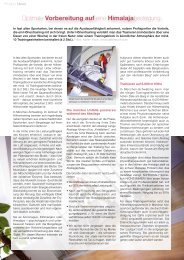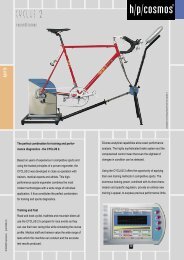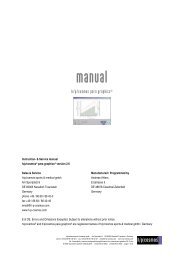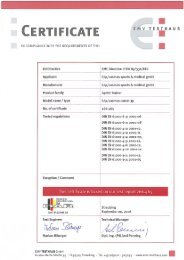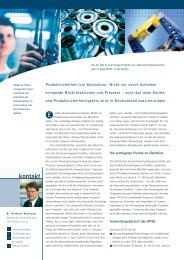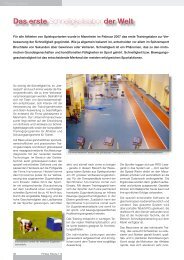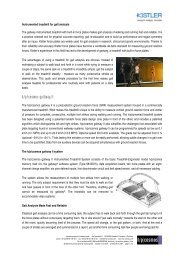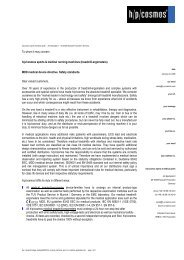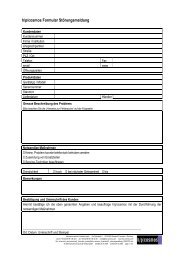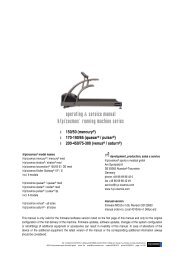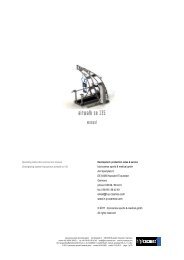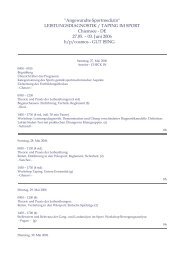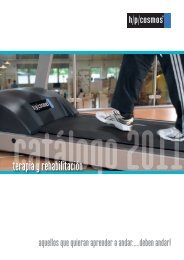running machine - H-P-COSMOS Sports and Medical
running machine - H-P-COSMOS Sports and Medical
running machine - H-P-COSMOS Sports and Medical
Create successful ePaper yourself
Turn your PDF publications into a flip-book with our unique Google optimized e-Paper software.
N During "reverse of belt rotation" (downhill run) a readjustment of the belt<br />
position (centring) is required.<br />
N Through evenly turning the left <strong>and</strong> the right trimming screw to the right you<br />
can tighten the <strong>running</strong> belt if necessary. See point <strong>running</strong> belt tension.<br />
maintenance & safety inspections<br />
Note: For <strong>running</strong> <strong>machine</strong>s with a <strong>running</strong> surface of 200 x 75 cm <strong>and</strong> bigger the trimming screw for the <strong>running</strong> belt is<br />
located at the front drive shaft. In this case the <strong>running</strong> belt movement is inverse after turning the screws.<br />
The hex socket must be pulled out of the screw immediately after usage due to risk of injury!<br />
[9.G] Control <strong>and</strong> tightening of the driving belt<br />
The correct tension of the driving belt is very important for a proper operation of the <strong>running</strong> <strong>machine</strong>. A too high tension<br />
can cause defects of the bearings from the motor <strong>and</strong> the roller. A too low tension results in backlash of the drive belt<br />
<strong>and</strong> therefore in higher abrasion <strong>and</strong> power losses.<br />
N This test can only be done with a dismounted motor hood. Don’t touch any parts in the motor<br />
compartment <strong>and</strong> take care not to be caught with long hair or loose clothes in the capture<br />
area of the danger zones.<br />
N For safety reasons the procedure of adjustment has to be supervised by a second person<br />
that can press the emergency-stop in an emergency.<br />
N Before intervening in the device for safety reasons switch the <strong>running</strong> <strong>machine</strong> off <strong>and</strong> pull<br />
the mains plug out.<br />
[9.G1] Driving belt with poly-V-belt system<br />
The poly-v-belt is provided with a belt adjuster <strong>and</strong> requires tightening usually very seldom. The belt adjuster offers<br />
the possibility of readjustment.<br />
N Checking the tightening of the drive belt with the „slipping-test“<br />
With the „slipping-test“ only a too low tension of the drive belt can be recognised. To be able to exclude a too high<br />
tension of the drive belt, the „frequency-test“ (see next point) must be used.<br />
The driving belt tension can be controlled according to point control of <strong>running</strong> belt tension.<br />
N Block the <strong>running</strong> belt at speed of 1 to 1.5 km/h.<br />
N No backlash must be between the motor shaft <strong>and</strong> the driving belt.<br />
N The tension at the bottom trumm (see picture) must be between 98 Hz <strong>and</strong> 103 Hz (frequency at oscillation).<br />
N The noise (at higher speeds) <strong>and</strong> the straight position of the driving belt need to be considered.<br />
file: n:\article\cos14310m5-v1_06hpc-en\20120215_cos14310m5-v1.06hpc-en_manual_h-p-cosmos_<strong>running</strong>_<strong>machine</strong>.doc<br />
© 2012 h/p/cosmos sports & medical gmbh email@h-p-cosmos.com created 15.02.2012 printed 15.02.2012 page: 136 of 213



